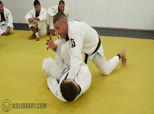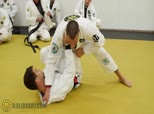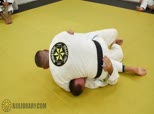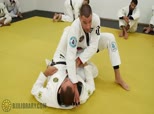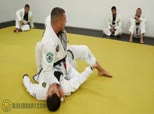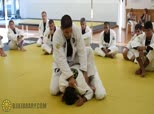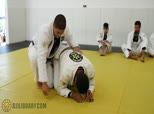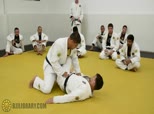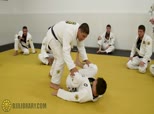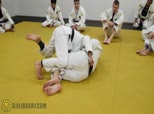Rafael Lovato Jr.'s Evolution of Jiu Jitsu 8 - Passing to Mount with Cross Collar Grip
Add to Favorites Remove From Favorites 709 2411 days ago
Rafael works for the same pass shown in the previous technique, but this time his opponent brings his inverted De La Riva hook to the the other side. Now when Rafael frees his trapped leg, he puts his knee forward to pin his opponent's thigh, most likely ending up in 3/4 mount position. Since he already has his cross collar grip, he can attack the neck and most likely his opponent will try to bridge to escape. This allows Rafael to settle in to full mount and work to submit.
Rafael Lovato Jr.'s Evolution of Jiu Jitsu 7 - Passing with the Thumb In Cross Collar Grip
Add to Favorites 818 Remove From Favorites 2412 days ago
While working from his headquarters position, Rafael's opponent turns and switches to an inverted De La Riva guard. With one hand already gripping the pants, Rafael turns his shoulder and toes to the knee and reaches across with his other hand to make the thumb in cross collar grip. He drops his outside knee to the mat for a solid base and pins the head using his forearm. Now he just stretches his leg until he breaks his opponent's grip and can pass to the side.Rafael Lovato Jr.'s Evolution of Jiu Jitsu 6 - Transitioning Between Knee Cut and Side Smash
Add to Favorites 785 Remove From Favorites 2413 days ago
Rafael touches on a few points of his passing game, including how he can transition between the knee cut and side smash passes. While working the knee cut, if his opponent tries to turn into the knee the opposite direction Rafael is facing, this is the time to go with his momentum and settle in on the side smash. From here he can go back the knee cut if necessary, and keep going back and forth until something opens up for him.Rafael Lovato Jr.'s Evolution of Jiu Jitsu 5 - Modified Guillotine Choke with Cross Collar Grip
Add to Favorites 891 Remove From Favorites 2414 days ago
Rafael uses his knee cut to pass the guard with his four fingers in cross collar grip, and his opponent begins to turn in to him and try to turtle. Rafael lets him turn a little and then stops him using shoulder pressure on the arm, and with his free arm, he reaches over the shoulder and grabs the belt. Now he flexes his wrist on the neck and clears his opponent's bottom arm with his knee, before switching his hips and dropping them to the mat. From here he keeps his ribs heavy on his opponent's face, squeezes with his elbow and wrist, and steps his leg over the body to finish the choke.Rafael Lovato Jr.'s Evolution of Jiu Jitsu 4 - When to Use the Thumb In Collar Grip
Add to Favorites 796 Remove From Favorites 2415 days ago
When using the cross knee or knee cut pass, the most important thing for Rafael is that he can use his elbow to put pressure on his opponent’s neck and face. With the thumb in collar grip, he has a hard time utilizing his elbow pressure, so he prefers to go four fingers in. However, in almost every other situation, Rafael will use the thumb in grip. This does not necessarily mean either is right or wrong, but this is what works for him.Rafael Lovato Jr.'s Evolution of Jiu Jitsu 3 - Knee Cut Pass with Cross Collar Grip
Add to Favorites 1009 Remove From Favorites 2416 days ago
With his knee in the middle, Rafael pushes his opponent's outside leg down and away, keeps a same side collar grip with his other hand and turns his knee to the inside with his weight on his opponent's core. Next he switches to a cross collar grip and pins his opponent's arm to the mat. He opens his elbow to put heavy pressure on the face and he cuts his knee through, keeping it facing away from his opponent with his hip heavy on his opponent's hips. He pulls the sleeve high as he completes his pass, and from here he can keep the pressure or easily transition to knee on belly.Inside the University 490 - Sinking In the First Hook
Add to Favorites 530 Remove From Favorites 2448 days ago
Many times while in turtle, Gustavo's opponent will keep his elbows tight inside his thighs to prevent Gustavo from getting his hooks in. In this case, Gustavo establishes his position on top of the back, with his shin resting on the thigh and his other foot looking to make a hook. From here, he can rock side to side and pull on the back of the collar, eventually creating the space he needs to sink his first hook in and roll his opponent to finish the back take.Inside the University 489 - Taking the Back from Turtle
Add to Favorites 605 Remove From Favorites 2449 days ago
Gustavo's opponent is in turtle position and keeping his elbows tight to his knees, so he makes a grip on the back of the collar and another on the far armpit of the gi as he reaches over the back. Next he places his nearside shin on his opponent's thigh and his other foot over the back and at the hip, looking to make a hook. While on top of the back, he pulls the collar and falls to the nearside, placing his far side hook in as he rolls his opponent. Next he can look to place his second hook and establish a solid back control.Inside the University 488 - Stay On Your Toes
Add to Favorites 513 Remove From Favorites 2457 days ago
Gustavo points out a mistake he sees where people are staying flat on their feet, which is throwing their balance off and not allowing them to react in time. Instead you should stay on your toes and be more agile and responsive. Also, when grabbing the shins, he keeps his hands moving fast so he doesn't allow his opponent to get any grips on him.Inside the University 487 - Pinning the Leg to Pass
Add to Favorites 606 Remove From Favorites 2458 days ago
Explaining some details in the previous technique, after Gustavo throws the legs to the side, he drops his inside knee to the floor right behind the his opponent's thighs, and reaches over the body to grab the lapel. Here traps the legs with his elbow and knee, and can move to side control or even take the back. In the next passing drill, he grabs the inside of the knee with a cross grip, pins it to the mat as he passes to the side, and makes a lapel grip or just pushes the chest down as he establishes side control.Inside the University 486 - Leg Push Passing Drill
Add to Favorites 497 Remove From Favorites 2460 days ago
Gustavo begins standing in front of his opponent who is laying on his back in an open guard position. As Gustavo steps in, he grabs both shins with his C-grips and pushes the legs in, causing his opponent to react by pushing them back out. Gustavo can do this a motion a few times, and as the legs come back out, he steps back and pushes them to the side, opening the space he needs to pass to side control.Inside the University 485 - Knee Spin Switching Sides Drill
Add to Favorites 626 Remove From Favorites 2461 days ago
Continuing from his side position after passing with the knee spin, now Rene's opponent turns to face him, so he immediately grabs his legs and pulls his knees down to the mat. He places his knee on top of his opponent's knees, moves his head inside on his opponent's chest, and back steps to the other side. For the drill, his opponent turns to face him again, and Rene repeats the movement. It's important to note that he is staying low and controlling the hips, rather than staying high in a typical cross body position.

